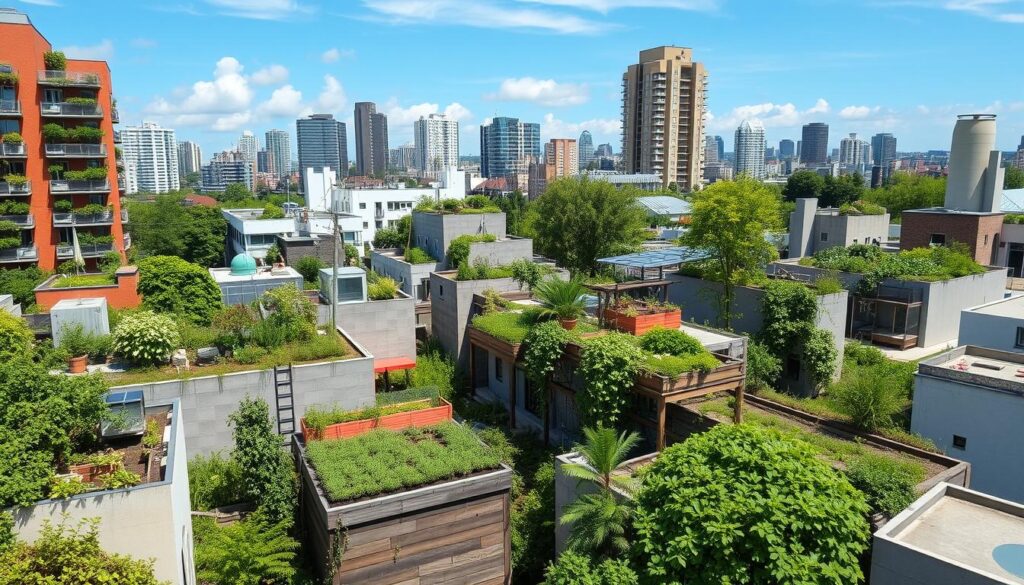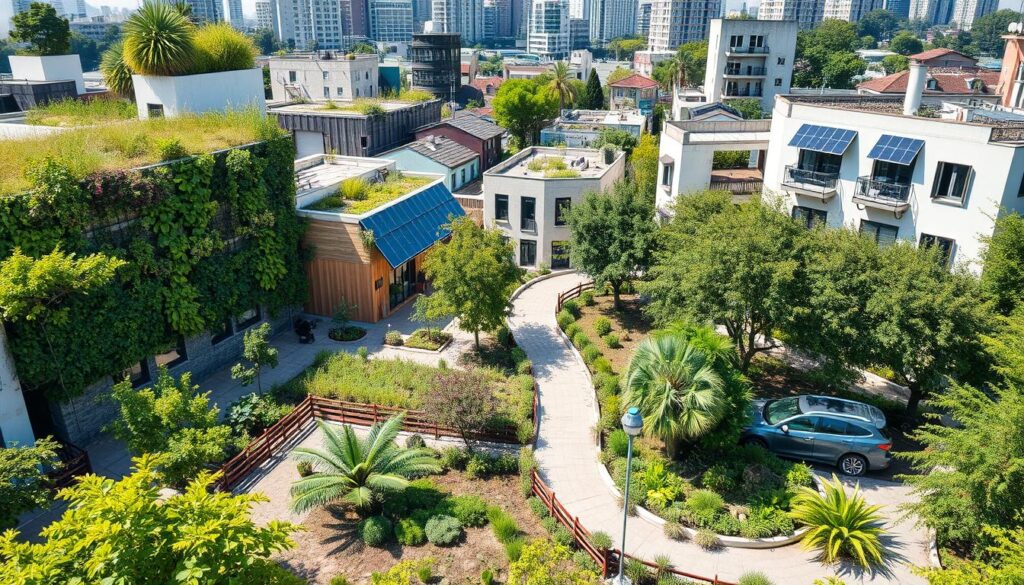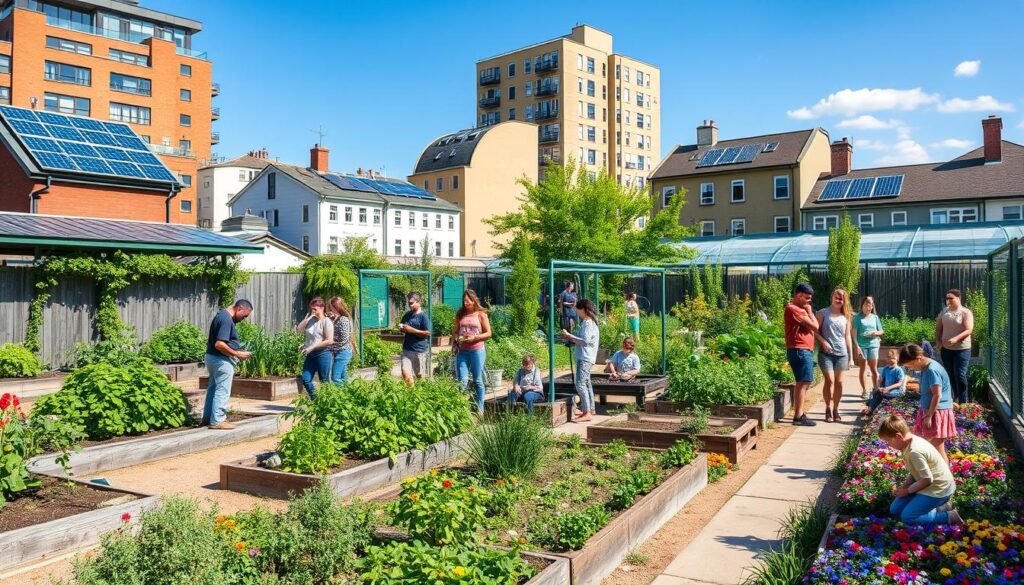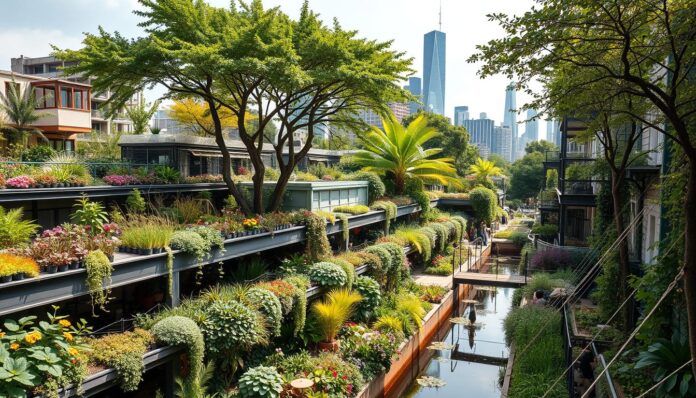Permaculture offers new ways to solve urban problems. It helps make cities better places to live. By using permaculture, cities can become green and productive.
People can grow a lot of food in small spaces. This is great for cities where space is limited. It helps make sure everyone has enough to eat.
Vertical gardens and rooftop gardens make the most of urban space. They help when land is scarce. Permaculture also cuts down on the need for long-distance food transport.
It also means less use of fossil fuels and water. This helps cities use less energy and water. It’s good for the planet and saves resources.
Permaculture is key for green cities. It makes cities better for people and the planet. It improves air and water quality.
It also brings people together. It encourages sharing and community. This makes cities feel more connected and welcoming.
Key Takeaways
- Permaculture spatial planning promotes sustainable landscape design and regenerative land use.
- Permaculture principles can be applied to create sustainable human environments and reduce reliance on conventional agriculture.
- Techniques such as vertical gardening and rooftop gardens increase the availability of planting space in urban environments.
- Permaculture spatial planning reduces dependence on fossil fuels and minimizes water waste.
- Permaculture principles foster community interconnectedness and resource sharing, promoting stronger social connections and a greater sense of belonging among community members.
- Permaculture spatial planning contributes to improved air and water quality, ultimately transforming urban areas into thriving ecosystems.
Introduction to Permaculture Urban Renewal
Permaculture is a way to design sustainable environments that work like nature. It focuses on making urban areas better by creating thriving ecosystems. This approach aims to make cities more sustainable and green.
By using permaculture, cities can become greener and more sustainable. It combines ecology, gardening, architecture, and more to support a healthy lifestyle. This mix helps cities become more environmentally friendly.
Definition of Permaculture
Permaculture comes from “PERMAnent” and “agriCULTURE,” showing its roots in sustainable farming. It uses different fields to make farming efficient and productive. This means cities and farms can work better together.
Importance in Urban Settings
Permaculture is key in cities because it builds strong, green ecosystems. It helps cities become more self-sufficient and less dependent on outside resources. This makes cities better for both people and the planet.
- Creation of resilient ecosystem designs
- Holistic site development
- Integration of various disciplines for sustainable lifestyles
By using permaculture, cities can become greener and more resilient. This leads to a better life for everyone living there.
| Aspect | Permaculture Approach | Benefits |
|---|---|---|
| Ecological Urban Design | Holistic site development | Resilient ecosystem designs |
| Sustainable Lifestyles | Integration of various disciplines | Maximized yields with low energy inputs |
Historical Context of Urban Renewal
Urban renewal has a long history, with many movements shaping city design. Recently, sustainable permaculture design has become key for eco-friendly cities. It focuses on green infrastructure planning and permaculture spatial planning for sustainable cities.
Urban design has changed due to social and economic shifts. Cities like Detroit and Pittsburgh have seen big changes. They’ve focused on sustainable permaculture design and green infrastructure planning for renewal.
Some notable urban renewal projects include:
- Oakland, California: Known for its innovative urban agriculture and permaculture spatial planning.
- Brooklyn, New York: A leader in urban renewal and sustainable permaculture design, with a strong community focus.
- Portland, Oregon: Emphasizes green infrastructure planning and permaculture spatial planning, with over 95 neighborhoods.

Sustainability movements are crucial in urban renewal. As cities grow, it’s vital to focus on sustainable permaculture design, green infrastructure planning, and permaculture spatial planning. This ensures resilient and thriving cities.
| City | Population | Urban Renewal Initiatives |
|---|---|---|
| Detroit | 677,116 | Regeneration efforts, focus on sustainable permaculture design |
| Pittsburgh | 302,400 | Regeneration efforts, focus on green infrastructure planning |
| Portland | 653,100 | Strong emphasis on permaculture spatial planning, over 95 distinct neighborhoods |
Key Principles of Permaculture
Permaculture is based on three main principles: Earth care, People care, and Fair share. These are key to making a system that’s sustainable and regenerative. By using regenerative land use methods, we can help the environment and save natural resources.
Using ecological urban design helps cities and towns thrive. It’s about working with nature, not against it. By applying holistic site development ideas, we can build strong and green communities.
Care for the Earth
This principle means we must take care of our planet and its resources. It’s about cutting down waste, using green energy, and supporting different species.
Care for People
This principle focuses on meeting everyone’s needs. It’s about giving people access to good food, clean water, and fighting for fairness and equality.
Fair Share
This principle is about sharing what we have fairly and working for justice. It’s about using less, recycling more, and supporting local businesses.
Benefits of Permaculture in Urban Areas
Permaculture in cities brings many benefits. It helps the environment, boosts the economy, and improves social ties. By using permaculture, cities can make their landscapes more sustainable. This reduces heat and pollution.
It also makes ecosystems stronger and more diverse. This is good for all living things.
Some main advantages of permaculture in cities are:
- Less carbon emissions and better waste handling
- More food grown locally and less pollution from transport
- Stronger community bonds and social strength
- Beautified cities and local economic growth
Green planning is key in urban permaculture. It includes parks and farms. These help manage water, clean the air, and support wildlife.
The Beacon Food Forest in Seattle and the Sherrett Food Forest in Portland, Oregon, show how it works. They’ve turned urban areas into lush ecosystems.

In summary, permaculture can make cities better. It makes them more sustainable, resilient, and livable. By using permaculture, cities can lessen their harm to the environment. They can also improve the health and happiness of their people, creating vibrant communities.
Assessing Urban Landscapes for Permaculture
More and more people live in cities, with about 54% of the world’s population in urban areas. This makes sustainable urban solutions like permaculture spatial planning crucial. Permaculture aims to design urban spaces efficiently, reduce waste, and balance nature.
It’s about looking at each site’s unique features and what its people need. This way, we can make cities better for everyone and the environment.
Ecological urban design is key to making cities sustainable and regenerative. By knowing local ecosystems and finding the right spots for permaculture, cities can lessen their environmental impact. This improves life for city dwellers.
Some important steps for assessing urban landscapes for permaculture include:
- Doing site analyses to find the best spots for permaculture
- Talking to local communities to learn what they need
- Designing spaces that support biodiversity and balance
By using permaculture and ecological urban design, cities can become better places for people and the planet. This approach brings many benefits, like less water runoff, more local wildlife, and cleaner air. As cities grow, the role of permaculture in making them sustainable will become even more vital.
Community Involvement in Permaculture Projects
Community involvement is key in permaculture projects. It helps create sustainable ecosystems. By working with local people and NGOs, we can design sustainable permaculture design that helps everyone. This also supports green infrastructure planning, which is vital for making cities better.
Here are some examples of community involvement in permaculture projects:
- Weekly permaculture education classes for community representatives
- Participatory design approaches that increase community ownership and foster deeper connections among residents
- Implementation of permaculture master-plan designs on large areas of land
These efforts show how important regenerative land use and community-driven design are. Together, we can build sustainable ecosystems. This leads to a better environment, stronger communities, and economic growth.

As we need more sustainable land use, community involvement in permaculture is crucial. It helps us build a better, fairer future for everyone.
| Year | Project | Outcome |
|---|---|---|
| 2019 | Permaculture Design Course | 40 participants trained |
| 2020 | Agroforestry plots installation | 35 families assisted |
| 2022 | Pilot agroforestry plots installation | 2 plots installed in indigenous communities |
Designing Permaculture Systems in Cities
More than half of the world’s people now live in cities. This makes it crucial to have sustainable urban ecosystems. Ecological urban design is key to making cities thrive. It uses permaculture to make cities more resilient and green.
Urban gardening, like rooftop and community gardens, boosts food production. It also helps cool cities down. Water-saving strategies, like collecting rainwater, ease the strain on city water systems. Practices like composting and mulching improve soil health, supporting local farming.
- Look at the site’s climate, soil, and water
- Plan for biodiversity and ecosystem services
- Work with the local community and stakeholders
By focusing on ecological design, cities can become better places. They become sustainable, resilient, and thriving. This approach emphasizes ecological urban design, holistic site development, and resilient ecosystems.
Case Studies of Successful Urban Renewal
Successful urban renewal projects use sustainable design and green planning. These methods make cities look better and help the environment. They also improve life for everyone living there.
Cities like Havana and Seattle show how it works. They use permaculture to make their spaces sustainable and healthy.
Lessons Learned from Implementation
Putting permaculture into urban areas needs careful thought. It’s about working with the local ecosystem and community. This way, cities can manage water, cool down, and support wildlife.
Important lessons include the value of community, creative use of space, and fitting into the city’s layout. By following these, cities can become greener and stronger. They will follow permaculture and green planning principles.
Challenges Faced in Urban Permaculture
Urban permaculture has big hurdles like limited space and rules to follow. These obstacles make it hard to use land in a green way. For example, cities don’t have much room for gardens or farms.
Some of the challenges associated with urban permaculture include:
- Space limitations: Urban areas often have limited space for gardening and farming.
- Regulatory hurdles: Zoning laws and regulations can restrict the use of urban spaces for permaculture.
- Lack of resources: Urban areas may lack access to resources such as water, soil, and organic matter.
But, we can still make urban permaculture work. We can use smart ideas like growing plants up walls, using water without soil, and working together for food. These methods help cities become greener and stronger.
| Challenge | Solution |
|---|---|
| Space limitations | Vertical gardening, hydroponics |
| Regulatory hurdles | Community-supported agriculture, advocacy |
| Lack of resources | Rainwater harvesting, composting |
Innovative Technologies Supporting Permaculture
Technologies are changing permaculture, making it more efficient and green. Sustainable permaculture design is key, using green infrastructure to create healthy ecosystems. It also focuses on using space and resources wisely.
Smart farming tech like hydroponics and aeroponics help grow crops indoors. Permaculture design software helps plan projects, considering climate, soil, and water.
These tools make permaculture better and more eco-friendly. They help farmers grow food sustainably and lessen environmental harm. By using these innovations, permaculture can help make our future greener and more resilient.
| Technology | Description | Benefits |
|---|---|---|
| Smart Urban Farming | Controlled environment agriculture | Increased crop yields, reduced water usage |
| Permaculture Design Software | Design and planning tool | Optimized use of space and resources, improved sustainability |
Educational Initiatives on Permaculture
Learning about permaculture is key to making our ecosystems better. Workshops and training programs teach people how to use ecological urban design principles. They focus on holistic site development and resilient ecosystem design to help ecosystems thrive.
Groups like the Permaculture Research Institute offer design courses and certifications. These are taught by experts like Alan Enzo and Steve Cran. They have lots of experience in permaculture and ecological restoration. Even colleges like Colby-Sawyer College teach permaculture as part of their sustainability major.
Learning about permaculture has many benefits. You gain knowledge of sustainable design, learn how to apply permaculture, and meet others who share your interests.
Supporting permaculture education helps us build a greener future. It encourages the use of ecological urban design, holistic site development, and resilient ecosystem design in our communities.
| Organization | Program | Location |
|---|---|---|
| Permaculture Research Institute | Permaculture Design Course | Australia |
| Colby-Sawyer College | Permaculture Design Course | USA |
Future Trends in Urban Permaculture
The world is getting more urban, with two-thirds of people expected to live in cities by 2050. This makes sustainable and regenerative urban ecosystems more crucial. Urban permaculture is gaining popularity, with cities embracing sustainable landscape design and green infrastructure planning. This helps make cities more livable and resilient.
Permaculture is becoming a key part of smart cities. By using permaculture spatial planning, cities can manage resources better and cut down on waste. Urban permaculture offers many benefits, such as:
- Increased biodiversity and ecosystem services
- Improved air and water quality
- Enhanced food security and access to fresh produce
- Reduced urban heat island effect and improved microclimates
As urban permaculture grows, we’ll see new and better ways to make cities sustainable. By applying permaculture principles, cities can become more resilient and better places for everyone.
Policy Recommendations for Supporting Permaculture
To make urban areas greener, we need policies that back regenerative land use and ecological urban design. Offering tax breaks or subsidies for gardens and green roofs can help. This way, cities can build sustainable ecosystems that help both the planet and people.
Creating policies that support permaculture is key. This includes changing zoning laws to make room for gardens and green spaces. By doing this, cities can become more self-sufficient and environmentally friendly. This is done through urban permaculture initiatives that mix food, energy, and water management.
Incentives for Urban Agriculture
- Tax incentives for urban farmers and community gardens
- Subsidies for green infrastructure and sustainable water management systems
- Grants for urban permaculture projects and initiatives
Zoning and Land Use Regulations
Updating zoning laws is vital for a greener city. By focusing on ecological urban design and holistic site development, cities can follow permaculture’s lead. This ensures urban growth is sustainable and resilient for the future.
Conclusion: The Future of Urban Renewal and Permaculture
Looking ahead, combining sustainable permaculture design, green planning, and permaculture will be key. This will help turn our cities into lively, strong, and green places. The 15-Minute City idea aims to cut energy use by 20-25% by 2050. It matches permaculture’s goals, focusing on easy access, community, and less fossil fuel use.
It’s important to keep pushing for permaculture’s urban renewal benefits to reach more people in the U.S. Working together with local governments, groups, and experts will help us achieve sustainable cities. A future where cities and nature live in harmony is possible. With dedication, we can make it happen.

